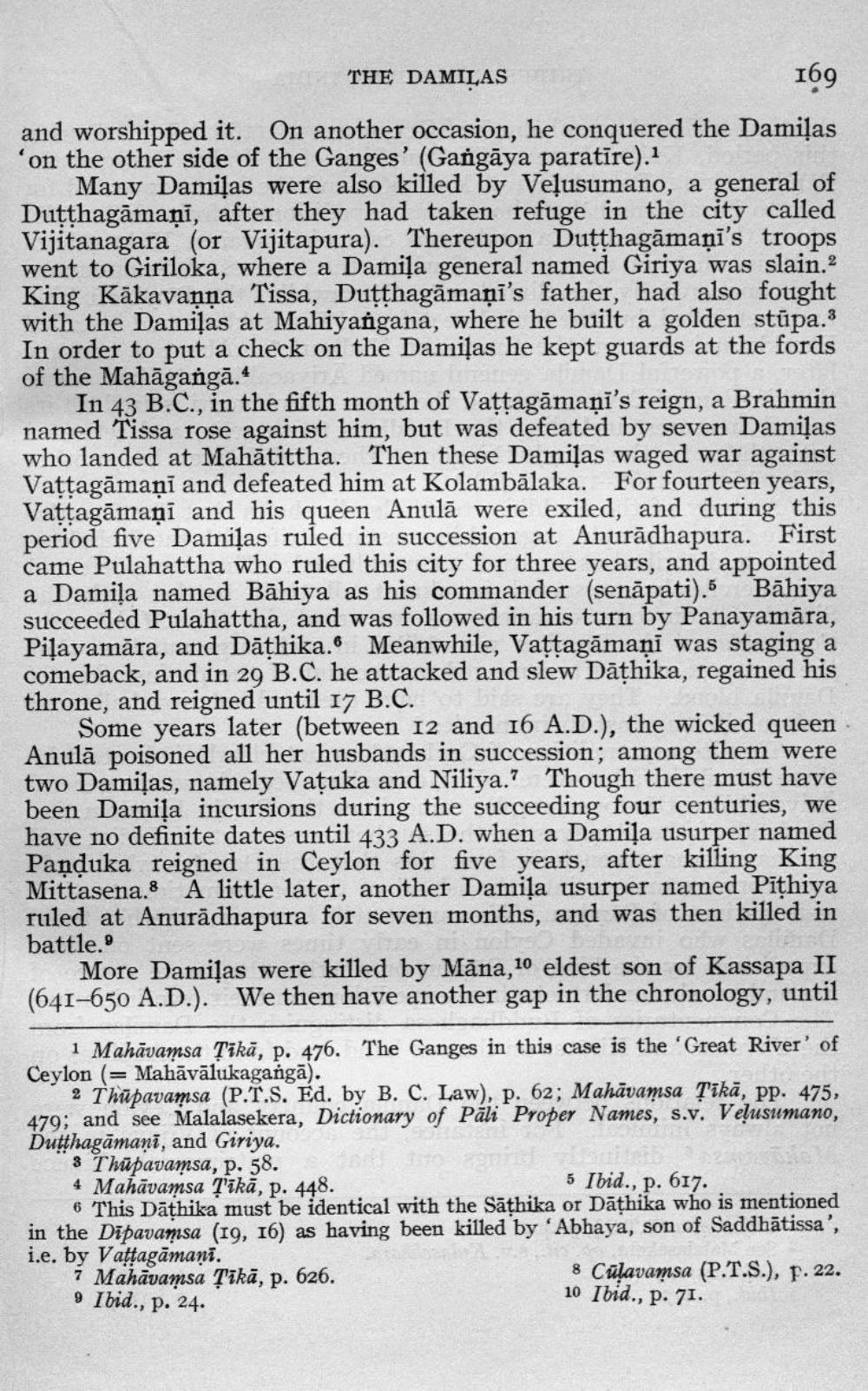________________
THE DAMILAS
169
and worshipped it. On another occasion, he conquered the Damilas ‘on the other side of the Ganges' (Gangāya paratire).
Many Damiļas were also killed by Velusumano, a general of Dutthagāmaṇī, after they had taken refuge in the city called Vijitanagara (or Vijitapura). Thereupon Dutthagāmaņi's troops went to Giriloka, where a Damiļa general named Giriya was slain.2 King Kākavanna Tissa, Dutthagāmaņi's father, had also fought with the Damiļas at Mahiyangana, where he built a golden stūpa.3 In order to put a check on the Damiļas he kept guards at the fords of the Mahāgangā.4
In 43 B.C., in the fifth month of Vattagāmaņi's reign, a Brahmin named Tissa rose against him, but was defeated by seven Damilas who landed at Mahātittha. Then these Damiļas waged war against Vattagāmaņī and defeated him at Kolambālaka. For fourteen years, Vattagāmaņi and his queen Anulā were exiled, and during this period five Damiļas ruled in succession at Anurādhapura. First came Pulahattha who ruled this city for three years, and appointed a Damila named Bāhiya as his commander (senāpati).5 Bāhiya succeeded Pulahattha, and was followed in his turn by Panayamāra, Pilayamāra, and Dāthika. Meanwhile, Vattagāmani was staging a comeback, and in 29 B.C. he attacked and slew Dāthika, regained his throne, and reigned until 17 B.C.de
Some years later (between 12 and 16 A.D.), the wicked queen Anulā poisoned all her husbands in succession; among them were two Damilas, namely Vatuka and Niliya.? Though there must have been Damiļa incursions during the succeeding four centuries, we have no definite dates until 433 A.D. when a Damiļa usurper named Paņduka reigned in Ceylon for five years, after killing King Mittasena.8 A little later, another Damiļa usurper named Pīthiya ruled at Anurādhapura for seven months, and was then killed in battle.
More Damiļas were killed by Māna,10 eldest son of Kassapa II (641-650 A.D.). We then have another gap in the chronology, until
1 Mahāvamsa Țikā, p. 476. The Ganges in this case is the 'Great River' of Ceylon (= Mahāvālukagangā).
2 Thüpavamsa (P.T.S. Ed. by B. C. Law), p. 62; Mahāvamsa sīkā, pp. 475, 479; and see Malalasekera, Dictionary of Pāli Proper Names, s.v. Veļusumano, Dutthagāmanī, and Giriya.
3 Thüpavamsa, p. 58. 4 Mahāvamsa Tīkā, p. 448.
5 Ibid., p. 617. 6 This Dāthika must be identical with the Sathika or Dāthika who is mentioned in the Dīpavamsa (19, 16) as having been killed by ‘Abhaya, son of Saddhātissa', i.e. by Vattagamani. 1 Mahāvamsa sīkā, p. 626.
8 Cūlavamsa (P.T.S.), p. 22. 9 Ibid., p. 24.
10 Ibid., p. 71.




